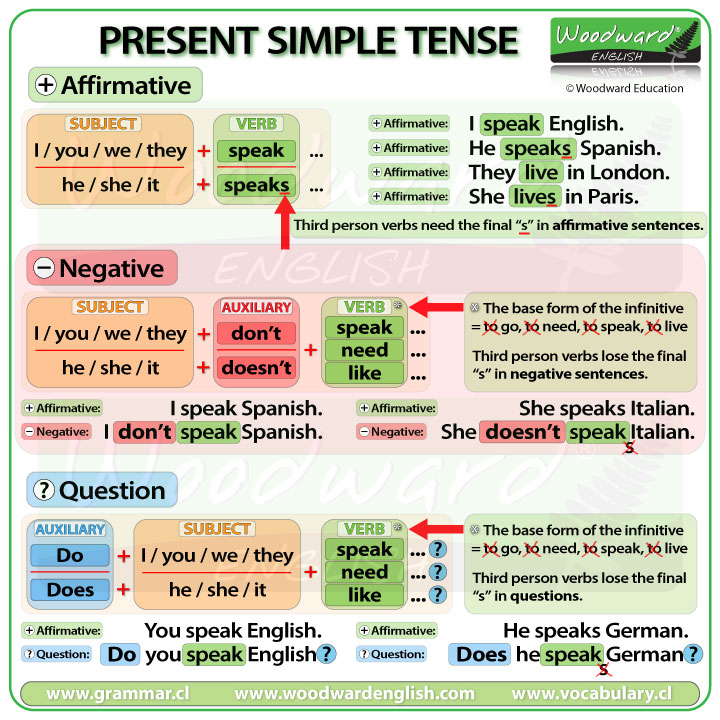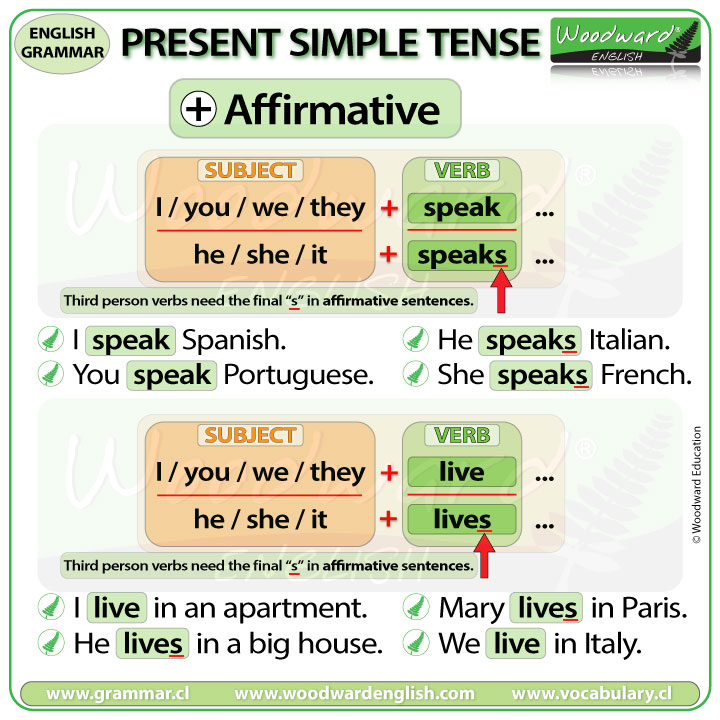
- I speak English.
“I” is a subject. In general, a person.
“Speak” is a verb. In general, an action.
You can change the subject. For example:
- You speak English.
BUT, sometimes the verb changes. We say:
- I speak …
- You speak …
- We speak …
- They speak …
BUT, For He / She / It we use SPEAKS with an S at the end.
The S is necessary at the end of a verb when the subject is HE, SHE, or IT.
- He speaks…
- She speaks…
- It speaks…
Look at these examples:
- I speak Spanish.
- You speak Portuguese.
But…
- He speaks Italian.

Sometimes the verb changes a little for HE, SHE and IT (third person).
Look at this verb: HAVE
We say:
- I have a good idea.
- You have black hair.
BUT, for He / She / It we use HAS.
We do NOT say Haves… because the verb is irregular.
Look at these examples:
- She has a dictionary.
- John has blue eyes.
Negative Sentences – Present Simple Tense
Look at this sentence:
- They speak English.
This is an affirmative sentence.
How can I make this a NEGATIVE sentence?
In English, we use don’t and doesn’t to make a negative sentence in present simple tense.*
- They speak English. … becomes …
- They don’t speak English.
* Exceptions: Negative sentences that use To Be or Modal Verbs (can, might, must, etc.)
When the subject is I, YOU, WE or THEY … we use don’t before the verb.
When the subject is HE, SHE or IT … we use doesn’t before the verb.
DON’T is a contraction of DO NOT.
DOESN’T is a contraction of DOES NOT.
After don’t and doesn’t we have a VERB.
This verb is the base form of the infinitive.
The infinitive is the original form of the verb before it is conjugated or changed.
The infinitive is to go, to need, to speak, to live.
But we want the BASE form of the infinitive… this is without the TO at the beginning.
- Instead of TO GO, only GO.
- instead of TO NEED, only NEED.
- Instead of TO SPEAK, only SPEAK.
- Instead of TO LIVE, only LIVE.
Let’s look at the example of the verb SPEAK. We say:
- I don’t speak …
- You don’t speak …
- We don’t speak …
- They don’t speak …
BUT, look at this affirmative sentence:
- He speaks Spanish.
What is the negative form of this sentence?
- He doesn’t speak Spanish.

Questions – Present Simple Tense
Look at this sentence.
- You speak English.
This is an affirmative sentence. What is the question?
- DO you speak English?
In English, we use DO and DOES to make questions in present simple tense.*
* Exceptions: Questions that have To Be or Modal Verbs (can, might, must, etc.)
- You speak English. (Affirmative sentence)
- Do you speak English? (Question)
The word DO at the beginning tells us it is a question.
Do is used for questions with I, you, we, and they.
Does is used for questions with he, she, and it.
Also the same rules apply to the verb in questions.
We use the base form of the infinitive.
For example, the affirmative sentence:
- He speaks German.
There is an S at the end of speaks because the subject is HE and it is an affirmative sentence.
What is the question?
- Does he speak German?

